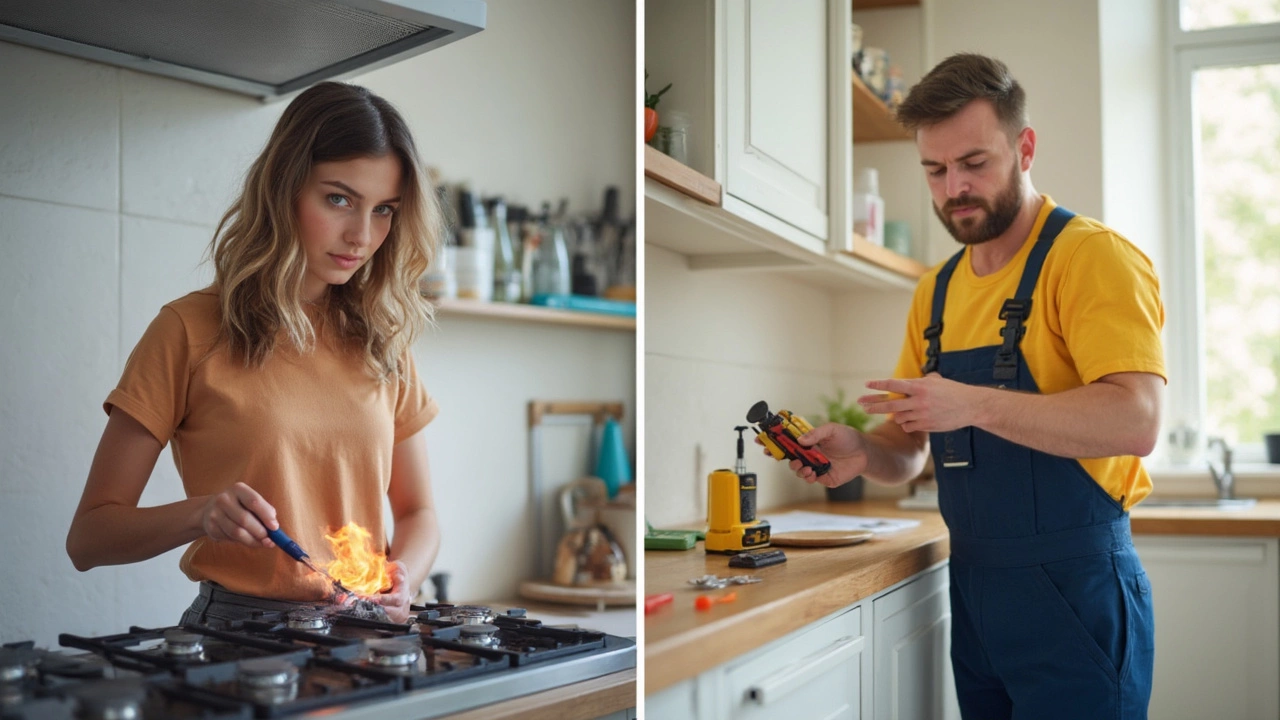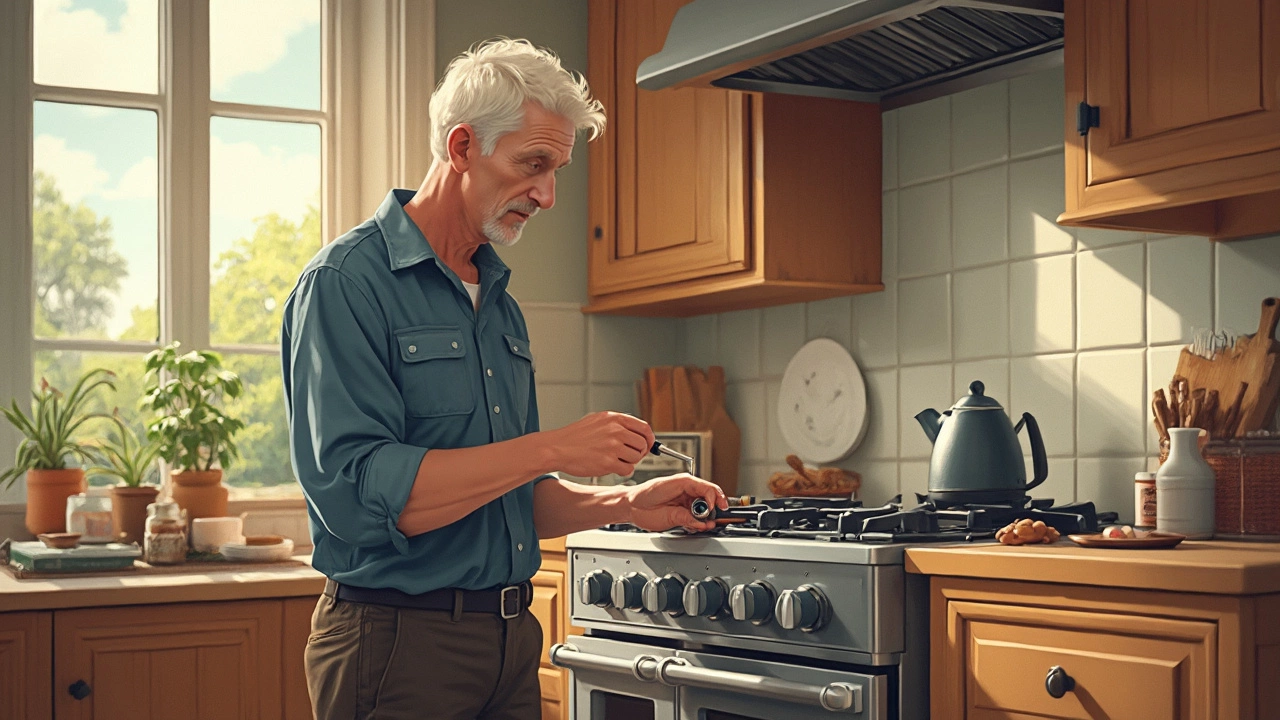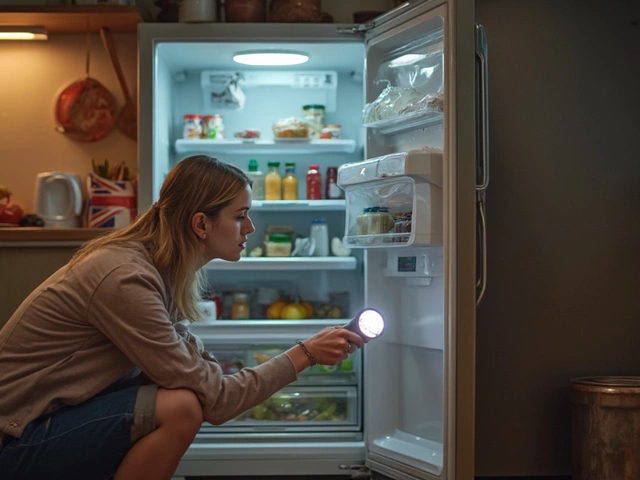No one likes it when dinner gets put on hold because the gas hob decides to play up. The good news is, most gas hob issues can be fixed, especially the usual suspects like burners not lighting or clicking sounds that just won’t quit. But before you fetch your toolbox, it’s smart to know what’s actually fixable at home and when you should save your fingers and ring up a professional.
Even if you’re handy, gas is one thing you shouldn’t mess with lightly. Trying to fix the wrong part can end up making things worse—or even dangerous. But don’t worry, some common hassles have pretty simple fixes. I’ll get straight into what you can check right now to see if it’s a quick job or a bigger problem.
- Common Gas Hob Problems
- DIY or Call the Pro?
- Quick Fixes You Can Try
- Safety Warnings You Can't Ignore
- Getting More Life Out of Your Gas Hob
Common Gas Hob Problems
If you’re standing in the kitchen and something’s not right with your gas hob, you’re definitely not alone. There are a handful of problems that pop up again and again, whether your hob is brand new or has seen a few years of action. Knowing exactly what you’re dealing with can save you a lot of time and stress.
The biggest complaint? Burners won’t light. This usually comes down to blocked jets, food build-up, or sometimes the igniter is just worn out. When you press the knob and hear nothing or only get a weak spark, chances are the ignition system needs some attention. Sometimes it’s as simple as a loose wire or battery, but in other cases, the igniter itself could be broken.
Another frustration is uneven heating, where one pan boils over while the other barely simmers. This often happens when the burner caps aren’t fitted right or there’s gunk blocking the flame holes. A quick cleaning or realignment solves this for most people.
Don’t overlook problems like clicking after the burner has lit. Constant clicking usually means moisture is stuck in the ignition, either from a spill or just steam. Give it some time to dry, or in a pinch, use a hair dryer on low to speed it up.
- gas hob repair often comes up when people notice weak flames. This can trace back to low gas pressure, a regulator issue, or those pesky blocked jets.
- Gas smells are never normal. If you notice a whiff of gas, turn off the hob, open windows, and call a professional. Don’t try to figure it out yourself.
- Control knobs getting stuck or turning too easily are usually caused by food or grease build-up underneath, which can be cleaned out once you remove the knobs.
The good news is that most of these problems have straightforward fixes, but knowing what you’re facing helps you decide if it’s a DIY job or time to call for backup.
DIY or Call the Pro?
It’s tempting to grab a screwdriver and sort out your gas hob repair yourself. But when is it safe to do so, and when should you get a professional involved? The reality is, some jobs are totally doable on your own, like cleaning blocked burners or fixing a loose control knob. Others, especially anything messing with gas supply or ignition systems, should go straight to a certified gas engineer.
Here’s a rundown of what you can likely manage yourself, versus what’s best left to someone with a gas-safe badge:
- DIY-Friendly:
- Cleaning grime or food debris from burner caps and heads
- Replacing worn pan supports or trivets
- Resetting a tripped spark ignition switch (just unplug and plug in again)
- Tightening loose control knobs or screws
- Call a Pro:
- Any repair involving internal gas lines or gas valves
- Fixing ignition modules or electric wiring issues
- Gas leaks (even if you just smell gas—leave the house and call emergency services)
- Replacing burner parts connected to the gas pipe
To put it into perspective, the Gas Safe Register says that in the UK, unqualified attempts at gas repairs cause hundreds of incidents each year. Most local laws also make it illegal to tamper with gas appliances unless you’re properly certified. Not worth the risk for the sake of saving a little cash.
Here’s a quick look at who should do what with your gas hob, so you’re not playing a guessing game:
| Problem | DIY | Call a Pro |
|---|---|---|
| Burner won’t light | ✓ (clean or check cap) | ✓ (if ongoing or gas not flowing) |
| Sparking stops | ✓ (reset switch) | ✓ (if persists) |
| Gas smell or leak | ✓ | |
| Control knob broken | ✓ | |
| Heat/flame uneven | ✓ (clean) | ✓ (if not solved by cleaning) |
If in doubt, always go safe and call a pro. You’ll sleep better at night, and your kitchen won’t get turned upside down by a DIY gone wrong.

Quick Fixes You Can Try
Sometimes your gas hob repair doesn’t have to be a big deal—just takes a bit of patience and knowing where to look. Here are the most common quick fixes you can do at home before picking up the phone for a service call.
- Burner Won’t Light? Make sure the burner cap is sitting flat. If it’s even slightly off-center, gas won’t flow right. Take off the cap, check for crumbs or grease, wipe it clean, then pop it back properly.
- Ignition Keeps Clicking? Moisture is the usual suspect here. Maybe you just spilled something or wiped the hob and water got in. Unplug the hob (or turn off the power at the wall), dry the ignition with a paper towel, and wait half an hour before trying again.
- Weak or Uneven Flames? Food gunk can block the hob’s tiny gas holes. Take a toothpick or a soft brush and gently poke the holes clear. Don’t use anything metal—a wooden skewer or old toothbrush does the trick.
- Noisy Flames or Yellow Tips? A noisy, hissing burner or yellow flames (instead of blue) means there’s not enough air mixing with the gas. Double-check the burner parts are assembled right, and see if the air adjustment shutter (usually underneath) is open just enough.
Here’s a quick look at how common these issues really are:
| Issue | Percent of Gas Hob Repairs | DIY Possible? |
|---|---|---|
| Burner won’t light | 44% | Yes |
| Ignition clicking non-stop | 27% | Yes |
| Weak flame | 15% | Yes |
| Gas smell or leaks | 6% | No—call a pro |
Simple habit: keep the burners clean every week, check the caps are on straight, and dry spills right away. It’ll probably save you most of the hassle.
Safety Warnings You Can't Ignore
Repairing a gas hob isn't like swapping out a light bulb. With gas, things can get risky fast if you don't follow some strict safety rules. Natural gas leaks are no joke—they can cause fires or even explosions if you fumble a job. Did you know that in the UK alone, the Gas Safe Register reports hundreds of gas-related incidents every year, most of them happening at home?
Here are some warnings and steps you should absolutely stick to:
- First off, if you smell gas (think rotten eggs), don't try to fix your gas hob. Turn off the main gas supply right away, open the windows, and get everyone out of the house. Call your emergency gas provider or the fire brigade once you’re outside.
- Before doing anything, make sure the hob’s control knobs are all off. Unplug the appliance if there's an electric spark feature.
- Don’t use lighters, matches, or even flip a light switch if you suspect a leak. Any spark can set off a fire.
- Never take apart the gas pipes or valves yourself. That’s professional territory—messing here could damage your entire supply line or worse.
- Always check your home insurance or landlord’s policy before making any fixes. DIY repairs can void cover and leave you footing the bill if things go south.
If you’re in doubt about anything, don’t guess—just ask a Gas Safe registered engineer. These pros train hard for a reason, and regulations say any work connected to gas supply (especially pipework or valves) has to be done by an approved specialist.
| Common Gas Hob Safety Mistakes | Potential Result |
|---|---|
| Ignoring a gas smell | Fire, explosion, poisoning |
| Trying to repair leaks with tape or glue | Leak worsens, major risk |
| Skipping ventilation when working | Gas buildup, health danger |
| Not switching off power/gas supply first | Shock, burns, fire |
The bottom line? Don’t cut corners with safety. It’s better to spend a bit more time, or even money, than risk your home—or your life—just to get dinner sorted.

Getting More Life Out of Your Gas Hob
If you want your gas hob to stick around for years without trouble, some basic habits actually make a real difference. These hobs aren’t designed to be disposable, but they need a little attention to go the distance.
The number one tip: regular cleaning. I know, it sounds boring, but leaving spills and grease pile up isn’t just messy—it clogs the burner holes, ruins the ignition, and can even make the flame uneven or weak. After cooking, let the hob cool and then wipe it down. For stubborn grime, a mix of baking soda and water does wonders without scratching up the surface.
- Gas hob repair gets way less likely when you stay on top of dirt and debris.
- Check burner caps are sitting straight. If they’re off-kilter, flames come out odd or sometimes not at all.
- Make sure the ignition ports aren’t blocked. Use a pin to gently clear out the tiny holes—no need for fancy gear.
- Look under the knobs every couple months. If they’re sticky or loose, pull them off and clean the posts. This stops gunk from jamming the mechanism.
Don’t forget about the vent and extractor fan. A blocked vent means more heat stays put, which isn’t great for your hob (or your face). Wash the filters in warm, soapy water every few weeks.
Want a real number to back this up? According to a 2024 UK home appliance survey, properly maintained gas hobs lasted nearly 2 years longer than ones that were neglected. That’s not small change, especially when a replacement hob can run you over £300.
| Care Level | Average Lifespan |
|---|---|
| Regular Maintenance | 12 years |
| Basic Cleaning Only | 10 years |
| Neglected | 7.5 years |
So, don’t just use your hob—look after it. It pays off, not just in how long it lasts, but also in how much safer and hassle-free your cooking stays.




